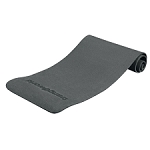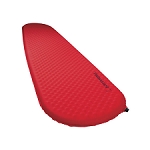It's not just about comfort: a mat is essential for preventing heat loss.

Sleeping mats are essential for a bivouac. Photo: Juan Corcuera
It may seem that a sleeping mat is not the kind of product that affects your safety or performance, but in reality it does. Bivouacs and restless nights caused by discomfort or the cold are exhausting, and in mountain environments this leads to reduced performance and a greater risk of injury or accidents.
Mats fulfil two purposes
- They insulate against the cold and humidity
- They provide comfort.
Padding provides comfort for your bones and improves quality of sleep, but even more important is its insulating function. Heat loss due to contact with cold, humid ground, even if you are on the groundsheet of your tent, drastically reduces the performance of a sleeping bag.
The R value
It is important to check the insulation capacity of your mat. This is usually indicated on the product.
The R-value of a mat measures its resistance to the heat flow. R is for Resistance to transmit heat, so the higher the R-value, the greater the insulation as less heat is lost.
The lowest value is 1, for use in warm, summer conditions. At 3.5 it begins to be suitable for winter conditions (although two mats are preferable). The higher the R-value, the better, but this also means an increase in weight. Camping mats can have an R-value of up to 15 and weigh around 4 kg.
Types of sleeping mats for mountain use
The choice of the best mat is strongly influenced by 3 factors:
- Weight
- Insulation capacity
- Padding (for comfort)
By deciding which of these three factors is a priority, you will be able to determine which mat is suitable for you. Consider the general climate conditions it will be used in. Using a mat for a snow bivy is not the same as for a summer night in a valley. The weight factor is also important if it is to be used for mountaineering or trekking. You may have to reach a compromise in terms of comfort, weight and insulation (although nowadays, ultralight mats provide an exceptional level of comfort and insulation for their weight).
There are 3 main types of mats
- 1. Foam
- 2. Inflatable
- 3. Self-inflating
1. Foam Mats
A classic sleeping mat, but the foam of today has evolved from a simple flat slab to more complex 3D designs, which minimise weight and increase comfort and insulation capacity.

Robens Zigzag Slumber 3D design
Open cell foam mats can still be found and at an economical price, but they are not recommended because they absorb moisture. Nowadays, only closed cell foam is used for mats as this kind of foam offers greater insulation.

Trangoworld Light Plus ultra-light mat
Benefits:
- Minimum weight.
- Can be attached to the outside of your pack.
- Great for sitting on during stops.
- Economical
- Very durable, practically indestructible. No maintenance required.
- A foam mat is perfect as a ground mat under the self-inflating model and light enough to be added to your pack. Not only does it provide extra insulation in winter climates, but also prevents punctures and tears in your self-inflating mat.
Disadvantages
- Rolled up, they occupy more space (although they can be attached to the outside of your pack)
- Lower R value. Not recommended for use in adverse climates or in the extreme cold (unless used as a protective layer under your inflatable mat).
2. Inflatable Mats
An inflatable mat is not dissimilar to a lilo or inflatable mattress, in that it is filled with air, but this is where the resemblance ends.
Depending on the thickness it offers the highest level of comfort, but the more comfortable it is, the heavier it gets.
Inflatable mats for mountain use have evolved greatly during the past few years.
- Brands now incorporate fibre insulation into the mat fabrics, increasing thermal capacity, which can reach R-value 5.
- Inflatable mats have always been light and compact, but new materials mean they are now significantly lighter without losing out on durability.

Therm-a-rest NeoAir Xlite Inflatable Mat
Benefits:
- High level of comfort
- Very packable, taking up little space
- Lightweight (mountain models weigh between 250 and 500 g)
- The latest mats reach an R-value of 5 or over, for winter use.
Disadvantages:
- Not the most durable kind of mat as it can tear or puncture (although they can be mended with a repair kit). Quite delicate for intense mountain use.
- With this kind of mat, low weight and high strength come at a price and mats that meet both criteria are usually expensive.
- Although uncommon, when inflating a mat in winter, the humidity of your breath can freeze on the inside, causing it to tear.
- Fluctuations in temperature change the air pressure, so the mat may feel as if it is deflating during the night.
- Not recommended for direct contact with the ground when bivying. A foam or similar protective layer should be used underneath.
- Having to puff away, inflating a mat after a long day’s hike is not always pleasant.
Regarding the last point, pumps for mountain use are now available that weigh approx. 50 g and take up very little space.
3. Self-inflating Mats
This type of mat often leads to confusion and many believe it is just an inflatable mat that inflates automatically.
However, self-inflatable mats for trekking are a hybrid between foam and inflatable mats, combining the insulating capacity of foam and the comfort of air.
The interior structure consists of foam cells, with air holes. When the mat is folded, these cells are compressed and the air holes are squashed. When unfolded, the foam cells suck in air through the open valve, filling the chambers inside.

Robens Fjellguard 60, self-inflating mat
Benefits:
- Usually very warm, so excellent for winter use (although lighter models with lower capacity exist).
- More durable than inflatable models and less prone to punctures, which makes them a good choice for mountain conditions.
- No sensation of air loss during the night as the temperature changes.
- More robust than the inflatable mats, due to their foam structure, more comfortable than the foam mats, due to the air chambers.
- Cheaper than inflatable mats
- Firmness of the mat can be adjusted by inflating more or less (although the inner foam structure means it cannot be inflated as much as an inflatable mat).
- To state the obvious: they self-inflate (although sometimes they need a bit of help)
Disadvantages
- Heavier than inflatable and foam mats (even though the latest models are much lighter, they usually weigh over 500 g. Those over one kilo are only for camping).
- Folded, they are less compact than inflatable mats; their foam cell interior takes up more space in your pack (although current high-end models take up less space than a water bottle).
- More durable than inflatable mats, but direct contact with the ground should be avoided, if possible.
Which One Do I Need?
You need to find the right balance between comfort, durability, R-value and weight.
Here are some examples to help you decide:
- If you are going camping in a car, with no problem of weight and space, you can choose a thick inflatable mattress.
- If you have to carry it in your backpack and may encounter bad weather conditions, choose a light self-inflatable, or inflatable mat (with a ground protection layer in case you need to bivy).
- In summer, you can opt for the resistance and durability of a foam mattress, especially if you plan to sleep out for several consecutive nights. But any other type of mattress will also do an excellent job.
- In winter, the best choice is a self-inflatable mat or an inflatable mat with thermal capacity. It is highly recommendable to combine either mat with a foam ground layer, (especially for inflatables) a foam layer weighs very little and can be easily attached to the outside of your pack.
Choosing Length and Width
All mats are available in different sizes. But it is not just a question of user height; some prefer a shorter length, regardless of their height, to save weight and space, especially in the case of self-inflatable mats.
Why?
It saves weight and space in your pack, but still protects: the trunk remains inside the mat and the areas that overflow can be protected by placing them on your backpack, (lower legs or feet) or as a pillow.
Of course, this system is not the most comfortable, nor does it provide as much insulation. But when weight is crucial, it plays the part.
The most technical mats have a mummy-shape rather than rectangular design in order to save weight and space. But they also limit movement when in use and this is something else to take into account when weighing the pros and cons of a mat. Some will prioritise weight, while others will prefer to carry a slightly heavier load in order to ensure greater sleeping comfort.















Leave a comment
Be the first to comment on this article.